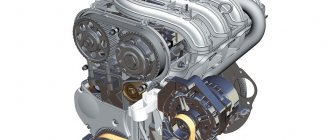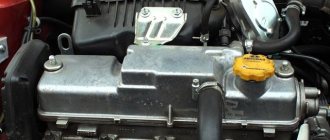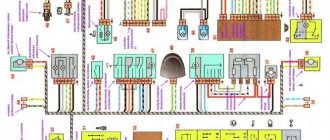The Lada Granta is a budget front-wheel drive car that was developed on the basis of the Lada Kalina. Sales of the car began at the end of December 2011. Currently, 5 types of engines are installed on Lada Granta/Kalina 2:
- VAZ-11183-50 (82 hp)
- VAZ-11186 (87 hp)
- VAZ-21126 (98 hp)
- VAZ-21127 (106 hp)
- VAZ 21126-77 (120 hp)
Despite this diversity, the volume of all engines is the same and is 1.6 liters.
For an increase of 3 hp. and 3 Nm, a large-scale modernization is hidden in the VAZ-11182 engine.
Lada Granta with a new engine: how does it drive? what resource?About modern VAZ engines
The manufacturer offers a choice of two 8 valve engines :
- VAZ-11183-50 (82 hp) is a modified VAZ-2111 engine, as a result of which environmental performance has increased, the engine has become more reliable and less capricious. It also has the advantage of elasticity and traction. Disadvantages include periodic valve adjustments and noisy engine operation. If the timing belt breaks, the valve does not bend.
- VAZ-11186 (87 hp) is a modified VAZ-21114 engine, as a result of which it was possible to reduce noise and gasoline consumption. Environmental friendliness has improved and power has increased noticeably. Disadvantages: compared to the VAZ-11183, this engine has a shorter service life. When the timing belt breaks, the valves bend.
16 valve engines :
- VAZ-21126 (98 hp) is a continuation of the VAZ-21124 engine and is currently one of the most advanced domestic engines. Disadvantage: valve bends when the timing belt breaks.
- VAZ-21127 (106 hp) is a modified VAZ-21126 engine. In comparison, the engine has become more torquey at the bottom, the changes are minor, but noticeable. The disadvantages include bending of the valves when the timing belt breaks.
Lada Granta 8 valve: main faults
Even taking into account the fact that the internal combustion engine of the Lada Granta 21116 is not the most complex unit structurally, certain problems associated with certain engine malfunctions may still arise during operation.
Main malfunctions and methods for their elimination:
- The occurrence of knocks and noises. The problem is misaligned valve clearances or defects in the pistons, connecting rods or crankshaft main bearings. The problem is eliminated by adjusting the gaps by repairing or replacing damaged parts;
- The occurrence of floating idle speed.
The problem is related to a failure in the electronic throttle control system “E-gas”, namely the failure of its sensors. The malfunction is determined by testing the system and replacing the sensors; The internal combustion engine begins to malfunction (dips occur, loss of power). Most often, this problem is associated with burnout of one of the valves or failure of the ignition coil. The problem is solved by restoring old parts or replacing them with new ones. - Normal warming up of the engine is disrupted or rapid overheating occurs (the engine “boils”). The problem is related to a broken thermostat. In this case, the thermostat is replaced;
- The car stalls while driving. This problem may be due to a malfunction of the mass air flow sensor;
- The appearance of oil leaks in the area of the oil cap and valve cover, etc. Oil can leak for various reasons: wear of the valve cover gasket, the appearance of defects on the valve cover itself, failure of the piston group, etc.
- It can also be noted that a collision of pistons with valves can cause serious damage. This happens when the pump bearing jams, the timing belt breaks, etc. As a result, expensive engine repairs will be required.
Lada Granta 21116 engine life, maintenance, pros and cons
The Lada Granta 21116 engine model under consideration differs from its predecessors in sufficient reliability and efficiency. If you take into account compliance with the operating and maintenance conditions (time frames for maintenance), you can significantly extend the service life of the unit.
Features of servicing the VAZ 21116 engine:
- The engine oil and oil filter are replaced every 15 thousand kilometers (recommended by the manufacturer);
- mandatory adjustment of valve clearances and replacement of the valve cover gasket;
- replacing spark plugs, air and fuel filters after 30 thousand kilometers;
- after a run of 90 thousand kilometers, they change the coolant, drive belts, high-voltage wires, etc.
If you study the reviews of VAZ 21116 owners, then the internal combustion engine of the Lada Granta 21116 with an engine capacity of 1.6 and a power of 87 horsepower pulls well at the bottom, as well as when driving at full power.
Fuel consumption per 100 km, even when driving in city traffic (traffic jams, traffic lights), usually does not exceed 10 liters. By the way, the use of AI-95 fuel recommended by the manufacturer can reduce fuel consumption even further.
We also recommend reading the article about how to do tuning the Lada Vesta engine. From this article you will learn about the available methods for tuning the Lada Vesta engine, how to increase power and boost the specified internal combustion engine.
You can also note the normal start of the engine in cold weather, even after the car has been idle for a long time. Also a plus is a reduction in noise (minimal vibration) and an increase in the torque of the internal combustion engine.
The only drawback is a broken engine timing belt, which leads to bending of the valves (as a result, expensive repairs). Also, in some cases, the fragility of the pistons is noted (when they collide with the valves, they sometimes break and require replacement much earlier than their allotted time);
Rules for operating motors
According to car owners, the biggest disadvantage in its design is the lack of an engine temperature sensor. This indicator is necessary to monitor the quality of the engine.
Overheating is the main enemy of the cylinder-piston system. The reasons for the increase in temperature in the engine may be a lack of antifreeze, insufficient cooling, etc. If the sensor is on, all of the above situations can lead to breakdown. To prevent this from happening, experts recommend installing a digital engine temperature indicator, which will accurately reflect the state of affairs.
In order to preserve the maximum resource of the engine, it is necessary to fully comply with the manufacturer’s recommendations for maintenance of the power unit.
Thus, the recommended frequency of engine checks is 15 thousand km. In this case, you do not need to wait for the indicator on the panel to inform you about any problem: it is easier to eliminate the prerequisites for a malfunction than the malfunction itself.
When the mileage reaches 30 thousand km, you will need to replace not only the oil, but also the power system filters and spark plugs, which will also be indicated by the indicator. Often, at this mileage level, the indicator begins to inform about problems in the engine. This could be a failed timing pulley or a faulty valve cover gasket. After a mileage of 45 thousand km, the indicator will indicate the need for an oil change.
If you take a responsible approach to car operation, the resource of the power unit can be increased by thousands of km.
Source
Main engines
As the main engines, AvtoVAZ offers customers a choice of the power units already mentioned just above. Let's talk about each of them separately.
VAZ-11186 (VAZ 21116)
VAZ 21116 is another representative of eight-valve engines with 87 hp. under the hood. It is a modified and improved VAZ-21114 engine, which is distinguished by a lower noise level and noticeable fuel economy. They are equipped with Grant's Norma vehicles.
If we compare the VAZ 21116 with the VAZ-21114, we should note a noticeably increased level of environmental friendliness, and the power has also increased significantly. The disadvantages of the engine include a more modest resource than, for example, that of the VAZ-11183. Its pistons are much lighter than those of its predecessor, but this circumstance led to the appearance of two more disadvantages.
So, in lighter pistons there is simply no room left for the recesses, therefore, if the belt breaks, the valves will definitely bend. Another disadvantage of such pistons is related to their fragility. For this reason, pistons can break when colliding with valves, and in four cases out of five such contact will require replacement.
Naturally, potential buyers will also be interested in the dynamic data of this engine. The presence of lighter pistons, which were already mentioned earlier, allowed the engine to increase not only in terms of power, but also in additional efficiency. Cars with such an engine reach speeds of up to 167 km/h, and acceleration from 0 to 100 meters will take them 12.4 seconds.
| Number of cylinders: | 4 |
| Cylinder displacement, l: | 1,597 |
| Compression ratio: | 10,5 |
| Rated engine power at a crankshaft speed of 5600 rpm: | 66 kW.-(90.0 hp) |
| Cylinder diameter, mm: | 82 |
| Piston stroke, mm: | 75,6 |
| Number of valves: | 8 |
| Minimum crankshaft speed, rpm: | 800-850 |
| Maximum torque at 3500 rpm, N*m: | 143 |
| Cylinder operating order: | 1-3-4-2 |
| Octane number of gasoline: | 95(unleaded) |
| Fuel supply system: | Electronically controlled distributed injection. |
| Spark plug: | A17DVRM, BPR6ES(NGK) |
VAZ 11183 (VAZ 21114)
Lada Kalina cars began to be equipped with VAZ 11183 (or VAZ 21114) power units in 2004, and then it was inherited by the Grant “standard”. This is a rather simple and primitive four-cylinder engine with 8 valves, producing 82 hp. and volume 1.6 l.
It cannot boast of solid power characteristics, but it does not cause any special problems when driving, and it is also very easy to maintain. It is distinguished by its environmental friendliness and reliability, while it also has good elasticity characteristics. In addition, this motor is known as one of the most torquey, especially at the bottom.
An important additional plus is a reliable timing system that prevents collisions between pistons and valves when the timing belt breaks.
But during operation of the motor, some disadvantages may be noted, in particular:
- Possible failure to turn the crankshaft with the starter;
- Strong noise when the starter is operating;
- Even after cranking the crankshaft, the engine may not start;
- There is instability when it is idling;
- The engine does not function at full capacity, which causes a loss of continuity. As a result, there are jerks when the car moves;
- The appearance of shots and claps;
- Increased fuel and oil consumption rates, insufficient oil pressure;
- The appearance of specific high-pitched knocking sounds when the load on the engine increases;
- Overheating of the engine or, conversely, the inability to warm it up to the required temperature for a long time;
- Constant operation of the electric fan, including on a cold engine;
- Reduced coolant level;
- The appearance of extraneous noise or strong vibration of the motor;
- While the engine is running, a signal indicating a malfunction of the power unit control system comes on.
| Number of cylinders: | 4 |
| Cylinder displacement, l: | 1,596 |
| Compression ratio: | 9,6-10 |
| Rated engine power at a crankshaft speed of 5200 rpm: | 60 kW.-(82 hp.) |
| Cylinder diameter, mm: | 82 |
| Piston stroke, mm: | 75,6 |
| Number of valves: | 8 |
| Minimum crankshaft speed, rpm: | 800 — 850 |
| Maximum torque at 2500-2700 rpm, N*m: | 120 |
| Cylinder operating order: | 1-3-4-2 |
| Octane number of gasoline: | 95 (unleaded) |
| Fuel supply system: | Electronically controlled distributed injection |
| Spark plug: | A17DVRM, BPR6ES(NGK) |
| Weight, kg: | 112 |
VAZ-21904
VAZ-21904 is a gasoline-powered sixteen-valve turbo engine with a displacement of 1.4 and a power of 163 hp. In addition, it is equipped with a lithium-ion battery and an electric motor. The basis for it was the VAZ-11194 engine; it was installed on Lada Kalina cars in the first generation. As for the VAZ-21904 itself, it is installed on Grant hybrids - VAZ-21904 sedans. The Volzhsky Automobile Plant tested four such vehicles equipped with three different hybrid engine options.
Fifth gear was replaced by the shaft of a robotic gearbox; it rotates thanks to a small electric motor with a power of 11 kW. This option turned out to be simpler and cheaper than using the standard scheme with the electric motor located between the gearbox and the internal combustion engine. Thus, there are four gears left, but this aspect will not create any problems for the car owner - the maximum speed (160 km/h) is achieved by the car in fourth gear.
Also, the terms of reference required the developers to fulfill two mandatory conditions - charging a hybrid car from electrical networks used in everyday life and the ability to move it in two modes at once - combined and electric. AvtoVAZ’s partners in the development of electronics were the Russian research institute NAMI and the Ricardo company from the UK. It was NAMI that developed the battery and electric motor for a hybrid car.
The car is capable of starting to move purely on electric power, with the internal combustion engine switched off. During the process of gaining speed, the gear shift will be carried out by a “robot”, and the precise output of the electric motor is responsible for synchronizing the rotation of the gears at this moment. When you start the gasoline engine, the car will begin to work in hybrid mode - with the same gear shifting, in which the electric motor will either help rotate the input shaft of the box, or will switch to generator mode, charging the battery.
According to tests, a hybrid car will consume 21% less fuel than a Granta with a conventional 1.6 engine. (measurements, of course, were carried out in a gentle mode, but the result obtained is very good).
Of course, only a few hope that the hybrid Lada Granta will be in great demand and will be able to generate any significant interest in the car market in the near future. At the moment, such vehicles are nothing more than a kind of aggregate carriers intended for testing various components separately. If we talk specifically about the hybrid type transmission, its serial production will begin in at least two to three years, and it will be installed on quite expensive Lada cars, most likely C-class. Thus, it is quite possible over time and we should expect an increase in demand for hybrid cars, but the main condition for this is a fundamental change in the attitude towards “ecological” transport not only of motorists, but also of the state, as well as the vehicle manufacturers themselves.
Engine on Grant: features
So, the Grant 21116 1.6-liter 8-valve gasoline engine is a modernized 1.6-liter VAZ 2114 engine. The idea to modernize the VAZ 2114 engine arose in connection with the release of the Grant car and the transition of the entire model range to Euro-4.
Initially, ICE 21116 was installed on the Lada Priora and then on the Lada Granta and Lada Kalina cars. List of main technical characteristics:
- injection power system;
- in-line 4-cylinder engine with a power of 87 hp;
- engine capacity 1596 cm3;
- the presence of two valves per cylinder;
- the maximum torque is 140 Nm;
- the presence of an intake manifold with extended channels and a flange for an electronic damper (increased torque);
- new H-module.
The 87 hp Grant engine, especially in comparison with its predecessor VAZ 21114, has a lightweight connecting rod and piston group. This feature of the 21116 engine has its advantages and disadvantages.
By lightening the parts and elements of the internal combustion engine, the service life of the valve-piston group decreases, but at the same time the dynamics and other indicators improve. For example, an increase in power to 87 hp, which is 6 hp. more than that of ICE 21114.
Main characteristics of the Lada Grand car with a VAZ 21116 engine installed on it:
- The maximum speed of the car is 167 km/h;
- Fuel consumption 8.5 l. per 100 km (when driving in the urban cycle);
- Fuel consumption 5.7 l. per 100 km (when driving on the highway);
Let's move on. If we consider the Granta 8-valve engine and its design, the Granta 8-valve engine has several design features that distinguish it from other modifications.
Firstly, the plate honing method is used to finalize the surfaces of the cylinders. Secondly, the presence of oil nozzles allows for more intensive lubrication and cooling of the pistons.
The dimensions of the internal combustion engine parts have also been reduced: the height of the cylinder block is about 197.1 mm; the crank radius is about 37.8 mm; piston ring height 1.2/1.5/2 mm, etc.
Another thing worth noting is the electromechanical throttle module installed at the receiver input. This design solution allows the ECU to fully control both the fuel supply and the air supply to the cylinders.
Let us add that the main design feature of the Grant 21116 internal combustion engine was the lightweight ShPG connecting rod and piston group. In the previous model, exhaust gas flows collided and created back pressure.
For this reason, in the case of the VAZ 21116, the designers decided to lengthen the collector pipes by changing the shape of the cylindrical block and the inlet pattern. As a result, such actions helped reduce losses and resistance.











